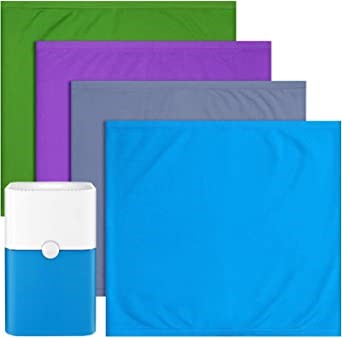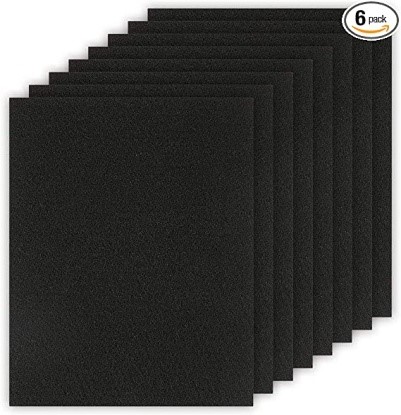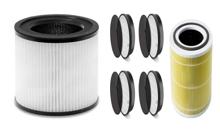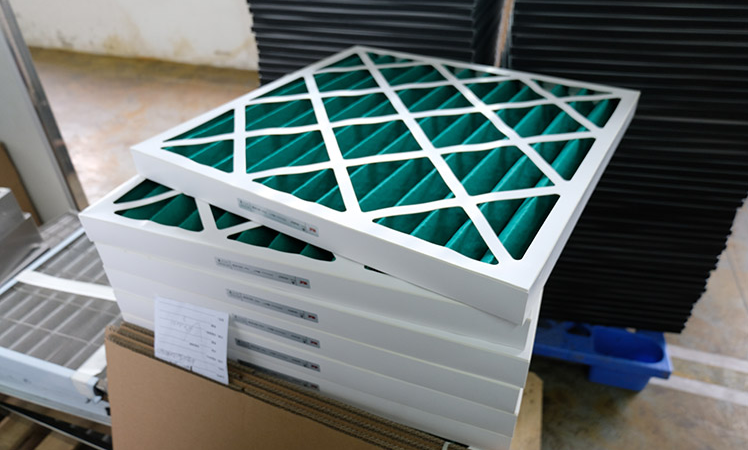Are you an air purifier user wanting to know more about how these wonder machines work? If so, then you’re in luck! Today we’ll be discussing What is a Pre-filter in an Air Purifier, the key role a pre-filter plays in your air purifier. Pre-filters are essential for trapping larger particles and ensuring that airborne dust, dander, and other pollutants have nowhere to hide. We’ll explore what pre-filters are made of, how they work within an air purifying system, and why they are paramount when it comes to removing any impurities from the air circulating in your home or office space. So if you’re looking to get under the hood of a typical air purification setup – stick around – as this post has all the answers.
IN THIS INFORMATIONAL ARTICLE
- What is a Pre-filter in an air purifier?
- Benefits of using a Pre-filter.
- The Problem with Pre-filters.
- Types of Pre-filter.
- How and when to clean the pre-filter in an air purifier?
- How to Choose the Right Pre-filter for Your Air Purifier?
- FAQs
- Final Thoughts
What is a Pre-filter in an air purifier?
Pre-filters are a crucial component of modern air purifiers, catching and containing large particles before they reach the primary filter – often a HEPA. This protective layer is essential in keeping main filters functioning optimally over time.
Best air purifiers for pets
The pre-filter is an essential addition to any HEPA filter system, as it captures pet hair, carpet fibers and larger dust particles before they have a chance to clog the main filtration unit. This extends the lifespan of your air purification equipment significantly.
HEPA filters are great for capturing larger particles; however their tendency to clog quickly leads to costly replacement. Installing a pre-filter offers an easier solution: maintenance is simple and you’ll save money with fewer HEPA filter replacements needed.
A variety of HEPA and carbon filters are utilized in 3-in-1 pre-filters, while single filters usually require special cleaning methods. Fortunately, most of these can be easily washed for continued use.
Pre-filters struggle to compare with the superior filtration capability of HEPA filters. Generally, they are rated in MERV 1-8 and yield a maximum efficiency rate between 20%-70%, trapping particles as small as 3 microns up to 10 microns – two orders of magnitude higher than some other filter technologies.
Benefits of Using a Pre-filter
A pre-filter can provide many benefits, including
- Increased air purification efficiency.
- Improved filter life (since it captures larger particles before they enter the main filtration system).
- Quieter operation (from reduced airflow resistance).
- Improved indoor.
The Problem with Pre-filters
Weak devices with inadequate airflow might suffer from having a “thick” pre-filter, which is often paired with carbon filters. In these cases, the presence of such a filter would likely be disadvantageous in terms of air quality and device performance.
Increased motor noise could arise if air intake vents become blocked. To test this, pre-filters were removed from powerful models of air purifier– yet surprisingly there was no decline in performance! This suggests that such a problem is not realistic and further testing may be necessary.
By keeping the pre-filter in place, you can ensure your device’s HEPA filter remains functional for a longer period of time and contribute to better air quality.
Types of Pre-filters
If you are looking to purify your air, the type of pre-filter used can make a major difference. From washable materials and electro statically charged fibers to activated carbon filters, there’s an array of options when it comes to choosing a pre-filter for your home or office. Each material has unique qualities that offer varying levels of clarity from dust and particles — all helping ensure healthier air quality.
- Washable Pre-filter.
- Carbon Pre-filter.
- Nylon Pre-filter.
- Washable Pre-filter

I am a firm believer that this type of pre-filter is the best option. It’s incredibly easy to maintain, yet just as efficient as any other pre-filters on the market. In most cases, these filters don’t need to be replaced at all – making it an economic and practical solution for anyone looking for a straightforward way to filter out contaminants from their water supply.
If you’re looking for a quick way to clean your pre-filter, go ahead and pop it in the washing machine. But if that’s not an option – no problem! You can also freshen this filter up with some soapy water at the sink or even give it a good old vacuuming. It all depends on what sort of material your particular filter is made from.
- Carbon Pre-filter

This filter is common on the market, and from my perspective, it’s a standard filter coated with carbon. Yet this pre-filter serves an additional purpose: It functions as the first line of defense before reaching the HEPA filtration level.
Best air Purifier for 1000 square feet in 2023
If adequate care isn’t taken, the pre-filter option might not stand up to extended use. Not only is it vulnerable when exposed to a vacuum cleaner, but also requires more frequent replacement than other filter options for sustained efficiency and performance over time.
To maintain the effectiveness of this pre-filter, it should not be washed at any time due to carbon loss.
- Nylon Pre-filter

The Nylon Fiber pre-filter is equipped with minuscule openings, ensuring that the majority of particles are removed and the HEPA filter is safeguarded.
This filter is much like the carbon pre-filters; however, it involves an extra layer of protection by being attached to another type of filter such as a HEPA.
This filter offers a hassle-free maintenance experience – all you need to do is simply vacuum dust with your household cleaner. Washing the pre-filter isn’t recommended, as it’s often assembled together with other components such as HEPA filters and circular 3-in 1 designs.
How and when to clean the pre-filter in an air purifier?
It is important to properly maintain an air purifier by regularly cleaning the pre-filter. Depending on the quality of your air and how heavily the system is used, you may need to clean the pre-filter every one to three months. It is best to check the filter often and clean it when it seems dirtier than usual.
To clean your air purifier pre-filter,
- You should first unplug the power cord from the power source and remove the filters.
- Vacuum or brush off any dust or dirt from the filter before submerging it in warm water with mild detergent.
- After soaking for about 10 minutes, rinse thoroughly with cold water until there are no more suds, and let the filter dry completely before reinstalling.
- If a vacuum cleaner is not available, you can use a brush to gently remove the dust particles from the filters.
It is important to make sure that the filter is completely dry before installing it back in your air purifier. Failure to do so may cause mold and mildew buildup in the filter and may even damage your appliance.
Additionally, regularly replacing your filters as recommended by the manufacturer is necessary for the optimal performance of your air purifier.
7 Best Air Purifier for Cat Urine Odor for Home
By following these simple steps, you can ensure that your air purifier continues to work efficiently and keeps your home environment clean and healthy.
How to Choose the Right Pre-filter for Your Air Purifier?
Choosing the right pre-filter for your air purifier is important for ensuring that you receive the best quality air in your home or office. Pre-filters are used in air purifiers to capture larger particles such as dust, pet dander, and pollen before they reach the main filter. The pre-filter should be changed regularly to prevent the main filter from becoming clogged.
Here are some tips to help you choose the right pre-filter for your air purifier:
1. Check the size of the pre-filter – Make sure that the pre-filter is compatible with your air purifier model and that it fits properly. If it is too large, it will reduce the efficiency of the air purifier. If it is too small, it won’t be able to capture enough pollutants.
2. Choose a pre-filter with the right filtration efficiency – Pre-filters can come in different types and sizes, each with varying levels of filtration efficiency. Choose a pre-filter that is rated to capture the pollutants you need it to.
3. Consider the cost – Generally, you will want to keep your costs low when choosing a pre-filter. However, be aware that cheaper filters may not provide the same level of filtration as more expensive ones.
4. Check the filter’s lifespan – Air purifier pre-filters generally need to be changed regularly. Knowing the expected lifespan of your pre-filter can help you plan for when to replace it.
By following these tips, you should be able to choose the right pre-filter for your air purifier and enjoy cleaner air in your home or office. If you’re still not sure which pre-filter is right for your air purifier, consult a professional who can help.
FAQs
- What is the purpose of the pre-filter?
The purpose of a pre-filter is to trap larger particles, such as dust and dirt before they enter the system. Pre-filters are typically used in combination with other filtration systems in order to extend the life of more expensive filters that would otherwise become clogged quickly.
- How long is the lifetime of Pre-Filters?
The lifetime of pre-filters can vary depending on the type and quality of the filter, as well as the environment and usage. Generally, pre-filters can last anywhere from 3 to 9 months under normal conditions. However, if the conditions are particularly dusty or polluted, the filters may need to be replaced more frequently in order to maintain effectiveness.
- Can I clean the pre-filter air purifier?
Yes, you can clean your pre-filter air purifier, but it is important to do so in the proper manner to ensure that it works as efficiently as possible. Cleaning the filter involves removing dust, dirt, and other particulates from the filter’s surface. This can be done by using a vacuum with an upholstery attachment.
- Are pre-filters reusable?
Pre-filters are typically designed to be reusable, although some models may require replacement more frequently than others. Reusability is largely dependent on the type and quality of the filter material. Generally, filters made from synthetic fibers such as polyester or nylon are more durable and can be used multiple times without needing to be replaced.
- Do you need a pre-filter in your air purifier to achieve optimal performance?
Using a pre-filter in an air purifier is an effective way to ensure you get the optimal performance from the purifier. Pre-filters are typically made of foam or fiberglass and are designed to trap larger particles such as dust, pet dander, and lint before they enter the main filter.
- What is the Most important Pre-filter in an Air Purifier?
The most important pre-filter in an air purifier is the HEPA filter – High Efficiency Particulate Arrestance. This type of filter is designed to capture particles as small as 0.3 microns in size, ensuring that even the smallest airborne pollutants are removed from the air.
Final Thoughts
A pre-filter is an important part of your air purifier as it helps to remove large particles from the air before they have a chance to reach and clog the HEPA filter. Pre-filters also play a role in prolonging the life of your HEPA filter by trapping these larger particles which would otherwise shorten the lifespan of your more expensive filter. While pre-filters are not perfect and do need to be replaced on a regular basis, they are an important part of any good air purification system.
With so many options on the market today, we understand that this can be a daunting task. Our team of experts have put together this helpful in-depth guide What is a Pre-filter in an Air Purifier? about to assist you in best overall knowledge with precision.
We are thankful for the time you spent perusing this guide. We hope it has given you useful information; kindly let us know how successful it was in resolving your questions.
———————————————————————————————————————
